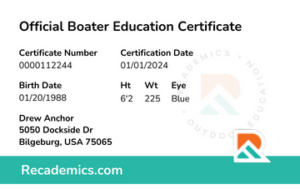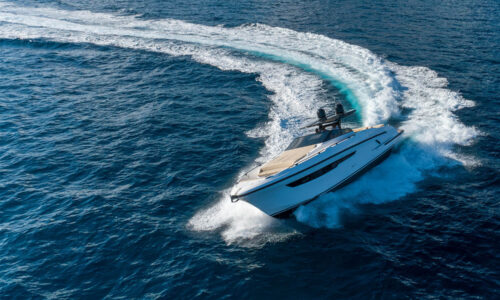Boating Right of Way: Avoid Collisions & Navigate Like a Pro
Key Takeaways:
- Stand-On vs. Give-Way: Know when to maintain course and when to yield to avoid collisions.
- Common Right-of-Way Rules: Learn how to navigate when meeting, crossing, or overtaking.
- Safety First: If the give-way vessel doesn’t act, take necessary steps to prevent an accident.
Table of Contents
Picture this: You’re out on the water, the sun is shining, and your boat is gliding across the waves. But suddenly—another boat is heading straight toward you! 
Boating isn’t just about having fun; it’s about safety and responsibility. Knowing right-of-way rules (aka the “Rules of the Road” for boating) ensures smooth sailing and prevents accidents. Let’s break it down so you can navigate with confidence.
Stand-On & Give-Way: Who Moves and Who Holds Course?
Every time two boats cross paths, one must yield. Here’s how it works:
Give-Way Vessel: The Boat That Yields
If you’re the give-way vessel, it’s your job to adjust your course or speed to avoid the other boat. You should:


Stand-On Vessel: The Boat That Holds Course
If you’re the stand-on vessel, your job is to maintain your course and speed. The only time you should change course is if the give-way vessel isn’t reacting properly and a collision is imminent. Stay alert, but expect the other boat to do its job.
What If the Give-Way Vessel Doesn’t Move?
While the give-way vessel is responsible for altering course or speed, sometimes operators may be distracted, inexperienced, or simply unaware of the rules. If you are the stand-on vessel and notice that the give-way vessel isn’t taking action, you are not required to hold your course at all costs. Safety comes first. If a collision seems imminent, you must do whatever is necessary to avoid it—whether that means slowing down, changing course, or signaling with sound blasts. Staying alert, anticipating other boaters’ actions, and always having an escape plan can make all the difference in preventing accidents.
Common Right-of-Way Situations on the Water
These are the three most common situations where right-of-way matters. These general right-of-way rules apply to most recreational boats, but they can vary based on the type of vessel involved—certain boats have special navigation priorities, which we’ll cover later in the article.
- Meeting Head-On: If two boats are approaching head-on, both should alter course to starboard (right) to pass safely.
- Crossing Paths: If another boat is approaching from your right (starboard), you must give way. If they are on your left (port), you are the stand-on vessel and should hold course.
- Overtaking Another Boat: The boat doing the overtaking always gives way, no matter which side they pass on. The boat being overtaken should maintain course and speed.
Using Sound Signals for Safe Boating
Sometimes, you need to communicate with other boaters to clarify your intentions. That’s where sound signals come in:



If you’re ever unsure about another boater’s actions, sound signals can clear up confusion and prevent accidents.

Get Safe. Get Certified.
Right-of-Way Priority: Which Vessel Has the Right of Way?
Not all vessels are equal when it comes to right-of-way. Some boats have limited maneuverability and must be given priority. Here’s the hierarchy of vessels, from highest to lowest priority:
| Priority | Vessel Type | Description |
|---|---|---|
| 1 | Vessels Not Under Command | Lost ability to maneuver; cannot avoid collisions. |
| 2 | Vessels Restricted in Their Ability to Maneuver | Performing tasks restricting maneuverability (e.g., laying cable, dredging). |
| 3 | Vessels Constrained by Their Draft | Deep-draft vessels confined to narrow channels. (Note: Applies to International Rules; not explicitly stated in Inland Rules.) |
| 4 | Fishing Vessels | Actively fishing with gear restricting maneuverability (not recreational fishing boats). |
| 5 | Sailing Vessels | Under sail alone, no engine power. |
| 6 | Power-Driven Vessels | Using engine power (motorboats, yachts). |
| 7 | Seaplanes | Aircraft on the water. |
🚨 Special Note: Many states have Move Over Laws, requiring boats to yield to law enforcement and emergency vessels when they are on duty.
Rules for Power-Driven Vessels
Powerboats and motorized vessels must give way to:
✔️ Boats not under command (i.e., adrift or broken down).
✔️ Boats restricted in maneuverability (e.g., towing, dredging, or laying cable).
✔️ Boats actively fishing with gear that restricts movement.
✔️ Sailboats under sail alone (unless the sailboat is overtaking).
Rules for Sailboats
Sailboats under wind power only (no engine) must give way to:
✔️ Boats not under command or restricted in their ability to maneuver.
✔️ Boats actively fishing with gear that limits movement.
🔹 However, when a sailboat uses its engine, it is considered a power-driven vessel and follows powerboat rules.
Rules for Fishing Boats While Underway
A boat engaged in commercial fishing with gear that restricts maneuverability must give way to:
✔️ Boats not under command or with restricted maneuverability.
✔️ Deep-draft vessels confined to narrow channels.
🎣 Recreational fishing boats do not have special privileges and must follow standard boating rules.
Navigating Narrow Channels
Some boats require deeper water and must remain in the center of a channel to avoid running aground. In narrow channels, the stand-on vessel is usually the one with the deepest draft.
🚤 Smaller, more maneuverable boats (including paddle craft) must give way and stay along the outer edges of the channel.
🚨 Always listen for sound signals in tight spaces, and be prepared to react quickly to avoid collisions.
Avoiding Collisions Comes First
The Rules of the Road provide a clear framework for safe navigation, but common sense and collision avoidance always take priority.
👉 If another boat isn’t yielding when it should, take action to avoid a crash!
✔️ Slow down, alter course, or signal with sound blasts.
✔️ Never assume another boater knows the rules—always stay alert.
Following these rules keeps everyone safe on the water and ensures a smooth, enjoyable boating experience.
Final Thoughts: Be the Boater Everyone Loves to Share the Water With
Following these right-of-way rules makes boating safer and more enjoyable for everyone. Stay alert, know when to stand-on or give-way, and use sound signals when needed.



Boating
- Alabama
- Alaska
- Arizona
- Arkansas
- California
- Colorado
- Connecticut
- Delaware
- Florida
- Georgia
- Hawaii
- Idaho
- Illinois
- Indiana
- Iowa
- Kansas
- Kentucky
- Louisiana
- Maine
- Maryland
- Massachusetts
- Michigan
- Minnesota
- Mississippi
- Missouri
- Montana
- Nebraska
- Nevada
- New Hampshire
- New Jersey
- New Mexico
- New York
- North Carolina
- North Dakota
- Ohio
- Oklahoma
- Oregon
- Pennsylvania
- Rhode Island
- South Carolina
- South Dakota
- Tennessee
- Texas
- Utah
- Vermont
- Virginia
- Washington
- West Virginia
- Wisconsin
- Wyoming


